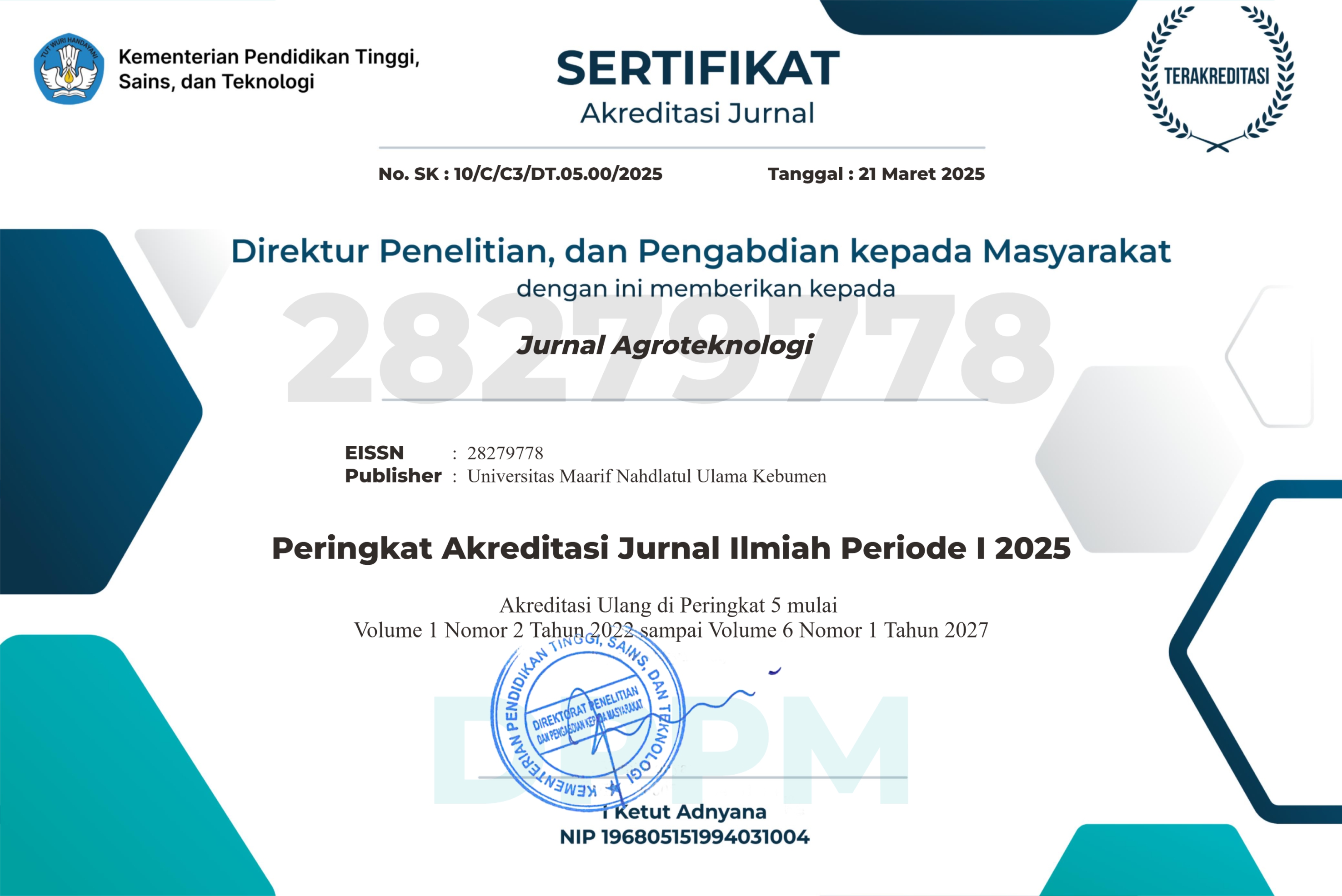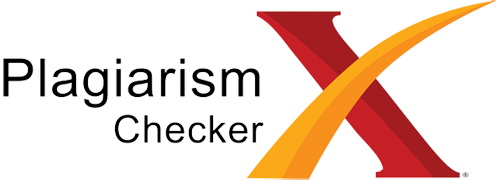Pengaruh Penggunaan Mulsa Jerami Padi dan Dosis KCl terhadap Produktivitas Kedelai (Glycine max L. Merr.) Kultivar Dering-1 pada Musim Kemarau
DOI:
https://doi.org/10.53863/agronu.v4i01.1418Keywords:
mulsa jerami padi, pupuk KCl, kedelai kultivar Dering-1, rice straw mulch, KCl fertilizer, soybean cultivar Dering-1.Abstract
Good environmental conditions and balanced fertilizer are factors that influence the soybean production process to obtain high crop yields. It is hoped that the use of rice straw mulch coupled with regulating the potassium dosage can create a good environment and the availability of sufficient and balanced nutrients for the growth of the Dering-1 cultivar soybean plants so that yields can increase. This research aims to determine the effect of the type of straw mulch and the dose of KCl fertilizer to increase the yield of the Dering-1 cultivar soybean. The research was carried out from August to November 2024 in Rancaekek Kencana Village, Bandung Regency with an altitude of around 700 meters above sea level. From August-October it is still dry, but at the end of October 2024 there will be rain although the intensity is still moderate. The research used a split plot design with three replications. The first factor is the dose of straw mulch consisting of three levels, namely without mulch, 2 tons/ha of rice straw and 4 tons/ha of rice straw. The second factor is the dose of KCl fertilizer consisting of four levels, namely 50 kg/ha KCl, 100 kg/ha KCl, 150 kg/ha KCl and 200 kg/ha KCl. Observations were made on the components of soybean yield and yield. The research results showed that there was an interaction between the dose of rice straw and the dose of KCl fertilizer on the number of pods per plant, seed weight per plant, harvest index and soybean yield per hectare, except for the weight of 100 grains per plant. The best treatment was a treatment dose of 4 tons/ha of rice straw and 150 kg/ha of KCl fertilizer, with a yield of 2.18 tons per hectare of dry beans with a water content of 14 percent.
References
Agustiyanti, E., Fredickus, B., & Purnomo, J. 2021. “Pengaruh Pemberian Mulsa Organik Dan Jarak Tanam Terhadap Pertumbuhan Dan Hasil Kedelai Edamame Pada Tanah Ultisol.” EnviroScienteae 17(2):71–77.
Balitkabi. 2012. “RENCANA STRATEGIS 2012.”
Barus, W.A., H. Khair, dan Hendri. 2017. “PERTUMBUHAN DAN PRODUKSI TANAMAN KACANG HIJAU (Vigna Radiata L.) TERHADAP PEMBERIAN KOMPOS BUNGA JANTAN KELAPA SAWIT DAN URIN KELINCI.” Agrium: Jurnal Ilmu Pertanian 21(1):55–61.
Benito. 2009. Pengaruh Pemupukan Kalium Klorida Dan Natrium Silikat Terhadap Tanaman (Zinnia Elegans Jacq).
Fan, Ya fang, Ju lin Gao, Ji ying Sun, Jian Liu, Zhi jun Su, Shu ping Hu, Zhi gang Wang, and Xiao fang Yu. 2022. “Potentials of Straw Return and Potassium Supply on Maize (Zea Mays L.) Photosynthesis, Dry Matter Accumulation and Yield.” Scientific Reports 12(1):1–10. doi: 10.1038/s41598-021-04508-w.
Fatmawati, Any. 2023. Fisiologi Tumbuhan Berbasis Riset.
Hadiyanti, Nugraheni, Aptika Hana Prastiwi Nareswari, Devina Cinantya Anindita, and Windy Sylviana. 2022. “Pengaruh Penggunaan Mulsa Dan Pupuk NPK Terhadap Produktivitas Kacang Hijau (Vigna Radiata L.).” Agrinika: Jurnal Agroteknologi Dan Agribisnis 6(1):1–9. doi: https://doi.org/10.30737/agrinika.v6i1.2281.
Hanum, C. 2018. “Growth, Yield and Movement of Phosphate Nutrients in Soybean on P Fertilizer, Straw Mulch and Difference of Plant Spacing.” Earth and Environmental Science 122.
Idawati. 2014. Pengaruh Pemupukan Kalium Terhadap Perkembangan Populasi Kutu Daun (Aphis Glycines Matsumura) Dan Hasil Kedelai.
Irfany, A., Nawawi, M., & Islami, T. 2016. “Pemberian Mulsa Jerami Padi Dan Pupuk Hijau Crotalaria Juncea L. Pada Pertumbuhan Dan Hasil Tanaman Jagung Varietas Kretek Tambin.” Jurnal Produksi Tanaman 4(6):454–61. doi: https://doi.org/10.21176/protan.v4i6.316.
Jamili, M. J., Sjofjan, J., & Amri, A. I. 2017. “Pengaruh Jerami Padi Dan Rasio Pupuk Urea, Tsp, Kcl Terhadap Pertumbuhan Dan Produksi Kedelai (Glycine Max (L) Merril.).” Jurnal Online Mahasiswa (JOM) Bidang Pertanian 4(1):1–15.
Kementrian Pertanian. 2020. “LAPORAN TAHUNAN 2020.”
Mangku. 2013. “Determination of the Best Method of Soil K Test for Tomato on Inceptisols Soil Type.” Horticulture 23(3):218–24.
Manwan. Ibrahim, Sumarno, A. Syarifudin Karama, Achmad M. Fagi. 1990. Tehnologi Peningkatan Produksi Kedelai di Indonesia. Pusat Penelitian Dan Pengembangan Pertanian.
Mokoginta, N., Musa, N., & Pembengo, W. 2017. “Keragaman Populasi Gulma Berdasarkan Aplikasi Mulsa Plastik, Mulsa Cangkang Telur Dan Mulsa Jerami Padi Pada Pertanaman Cabai (Capsicum Annum L). Jatt.” Jatt. Jurnal Online Mahasiswa 6(3):330–37. doi: https://doi.org/10.35334/jpen.v4i1.1919.
Nugroho, M. H., Dharma, I. P., & Trigunasih, N. M. 2020. “Pengaruh Jarak Tanam Dan Mulsa Jerami Padi Terhadap Pertumbuhan Dan Hasil Tanaman Jagung (Zea Mays L.). o Title.” Jurnal Agroekoteknologi Tropika 9(4):248–57.
Nurbaiti, F., Haryono, G., & Suprapto, A. 2017. “Pengaruh Giberelin Terhadap Viabilitas Dan Vigor Benih Kedelai.” Jurnal Ilmu Pertanian Tropika Dan Subtropika 2(2):41–47. doi: https://doi.org/10.31002/vigor.v2i2.486.
Oldeman, L. R. 1975. Contribution: An Agro-Climatic Map of Java and Madura.
Purba, Jhon Hardy, I. Putu Parmila, and Kadek Karimas Sari. 2018. “PENGARUH PUPUK KANDANG SAPI DAN JARAK TANAM TERHADAP PERTUMBUHAN DAN HASIL KEDELAI (Glycine Max L. Merrill) VARIETAS EDAMAME.” Agro Bali: Agricultural Journal 1(2):69–81. doi: 10.37637/ab.v1i2.308.
Purwowidodo. 1983. “Tehnologi Mulsa.” Pp. 86–151 in Teknologi Mulsa.
R. E., R. Irawaty, Rahni N. M., Gusnawaty G., and & Hasid. 2019. “Respons Tanaman Kedelai (Glycine Max L.) Terhadap Aplikasi Bokasi Plus Pada Lahan Kering Marjinal.” Berkala Penelitian Agronomi 7(1):45–64.
Riyaningsih, Amalia Dita, Supriyono Supriyono, dan Jauhari Syamsiyah. 2018. “Pertumbuhan Dan Hasil Kacang Hijau Dari Berbagai Populasi Dengan Mulsa Organik.” Agrotechnology Research Journal 2(2):58–62. doi: http://dx.doi.org/10.20961/agrotechresj.v2i2.22052.
Rogomulyo. 2014. “The Residual Effect of Vinasse And Potassium Fertilizer On Growth And Yield Of Land Kale (Ipomoea Reptans Poir.).” Vegetalika 3(1):12–21.
Rohmah, Eka Afiyanti, and Bagus Saputro. 2016. “Analisis Pertumbuhan Tanaman Kedelai (Glycine Max L.) Varietas Grobogan Pada Kondisi Cekaman Genangan.” Jurnal Sains Dan Seni ITS 5(2):2337–3520.
Somoatmodjo, Sadikin. 1985. Kedelai.
Yusuf, M.F.B., P. Yudono, dan S. Purwanti. 2015. “PENGARUH MULSA ORGANIK TERHADAP PERTUMBUHAN DAN HASIL BENIH TIGA KULTIVAR KACANG HIJAU (Vigna Radiata L. Wilczek) DI LAHAN PASIR PANTAI.” Vegetalika 4(3):85–97. doi: https://doi.org/10.22146/veg.10479.
Downloads
Published
How to Cite
Issue
Section
License
Copyright (c) 2025 A.W. Irwan, T. Sunarto

This work is licensed under a Creative Commons Attribution-ShareAlike 4.0 International License.
Authors retain copyright and grant the journal right of first publication with the work simultaneously licensed under a Creative Commons Attribution-ShareAlike 4.0 International License that allows others to share the work with an acknowledgment of the work’s authorship and initial publication in this journal











